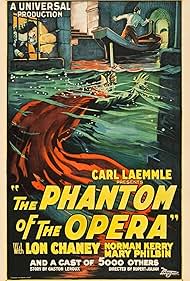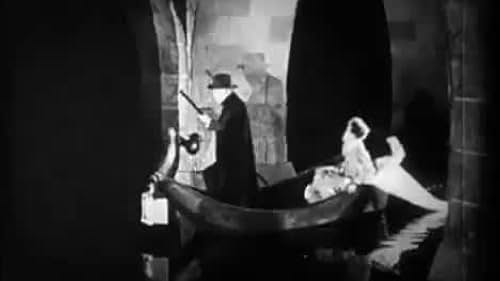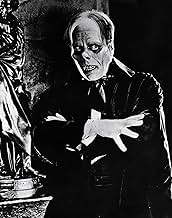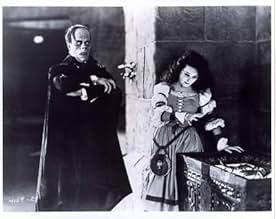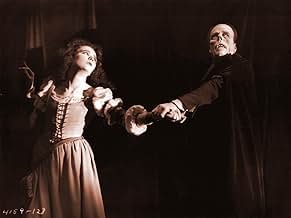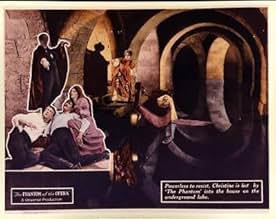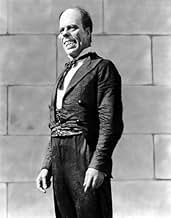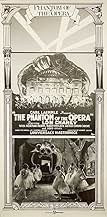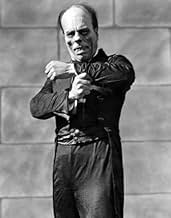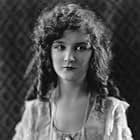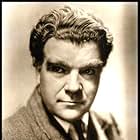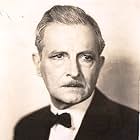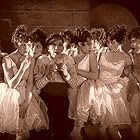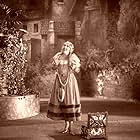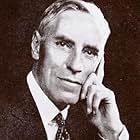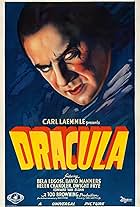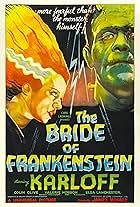A mad, disfigured composer seeks love with a lovely young opera singer.A mad, disfigured composer seeks love with a lovely young opera singer.A mad, disfigured composer seeks love with a lovely young opera singer.
- Awards
- 4 wins & 1 nomination
John St. Polis
- Comte Philip de Chagny
- (as John Sainpolis)
Virginia Pearson
- Carlotta
- (1929 re-edited version)
- …
Olive Ann Alcorn
- La Sorelli
- (uncredited)
Betty Allen
- Ballerina
- (uncredited)
Betty Arthur
- Ballet Dancer
- (uncredited)
Joseph Belmont
- Stage Manager
- (uncredited)
Alexander Bevani
- Mephistopheles
- (uncredited)
Earl Gordon Bostwick
- Minor Role
- (uncredited)
Ethel Broadhurst
- Frightened Ballerina
- (uncredited)
Edward Cecil
- Faust
- (uncredited)
Storyline
Did you know
- TriviaLon Chaney's horrific, self-applied makeup was kept secret right up until the film's premiere. Not a single photograph of Chaney as The Phantom was published in a newspaper or magazine or seen anywhere before the film opened in theaters. Universal Pictures wanted The Phantom's face to be a complete surprise when his mask was ripped off.
- Goofs(1929 cut) When the Phantom's alarm goes off, the sound of the chimes does not always match the striking of the device's "arms". That is because what is heard is the film's soundtrack, not "sound effects", which do not exist in a silent film. As such, this being "off sync" is allowable.
- Quotes
The Phantom: [Christine sees a casket in the room] That is where I sleep. It keeps me reminded of that other dreamless sleep that cures all ills - forever!
Christine Daae: You - You are the Phantom!
The Phantom: If I am the Phantom, it is because man's hatred has made me so. If I shall be saved, it will be because your love redeems me.
- Crazy creditsIn 1925 (and for many years afterwards), credits used to appear at the beginning of movies. In this film, the credits do appear at the beginning but also are repeated at the end, preceded by the following caption: "This is repeated at the request of picture patrons who desire to check the names of performers whose work has pleased them."
- Alternate versionsIn 2012 it was determined that an "accidental 3-D" version of the film existed. From an examination of various prints of the film, it was discovered that most - if not all - of the original film was shot using two cameras placed side-by-side. This was most likely done to create simultaneous master and safety/domestic and foreign negatives of the film. However, when synched together and anaglyph color-tinted, the spatial distance between the two simultaneous film strips translates into an effective 3-D film. Under the working title of LA FANTOME 3D, a fund-raising effort is under way to locate and restore (create) a full "accidental 3-D" version of the film.
- ConnectionsEdited into Drácula (1931)
Featured review
My goodness...close to fifty years ago I saw this film in the company of its leading lady, Mary Philbin. She was a friend of an unforgettable lady our family had met when we moved from New England to southern California. Our mutual friend was constantly prodding Miss Philbin, who had become quite reclusive after retiring from the screen, to get out and enjoy life. (They took a trip to Europe one summer, for instance.) One evening she persuaded Mary, who was extremely reluctant, by the way, to accompany us to the silent movie theater on Fairfax Ave., not far from Hollywood Blvd. and the site of Grauman's Chinese Theater and other first-run movie palaces, to see a revival of "The Phantom of the Opera." That old theater, not in the least luxurious and quite small, was a virtual shrine for lovers of silent films. Management had obtained a print of this film in acceptable condition, though I don't recall that the Technicolor sequence had been preserved in that print and, on that evening anyway, there was no musical accompaniment.
Mary dreaded the experience of seeing one of her old films amid a mid-Fifties audience, which she feared would find the film a subject of comical curiosity rather than a piece of genuinely enthralling entertainment. We joined the rest of the audience that night in enjoying the experience of seeing the film, however, and Mary was relieved that she had consented to accompany us (though she insisted that we shield her from any possible recognition, not too easy to do, since she had hardly changed in appearance in the quarter-century since that classic's production.) I, for one, remember being amazed at the care and expense that had obviously been lavished on its production.
Not very long after that evening, we went to a neighborhood theater in Pacific Palisades, Calif., to see James Cagney in the 1957 Universal-International biographical film about Lon Chaney, Sr., "Man of a Thousand Faces," again with Mary Philbin in our company. The unmasking scene from "The Phantom of the Opera" was rather perfunctorily recreated, with an actress playing Mary who did not resemble her. As we exited the theater, Mary and our family friend, who had quite a few early Hollywood associations (She had once been married to Ernst Lubitsch, the legendary director, when they first came to Hollywood from their native Germany.), regaled me with reminiscences about Irving Thalberg (played in the film by a young Robert Evans), whom they had both known and for whom they had quite a high regard.
Mary remained a family friend over the years until her death more than thirty years later. She led a very quiet life, for many years occupying a house she had owned since the days of her stardom (only a few blocks north on Fairfax Ave. from that silent movie revival house!) I remember her with great fondness for her modesty and extraordinary sweetness.
Mary dreaded the experience of seeing one of her old films amid a mid-Fifties audience, which she feared would find the film a subject of comical curiosity rather than a piece of genuinely enthralling entertainment. We joined the rest of the audience that night in enjoying the experience of seeing the film, however, and Mary was relieved that she had consented to accompany us (though she insisted that we shield her from any possible recognition, not too easy to do, since she had hardly changed in appearance in the quarter-century since that classic's production.) I, for one, remember being amazed at the care and expense that had obviously been lavished on its production.
Not very long after that evening, we went to a neighborhood theater in Pacific Palisades, Calif., to see James Cagney in the 1957 Universal-International biographical film about Lon Chaney, Sr., "Man of a Thousand Faces," again with Mary Philbin in our company. The unmasking scene from "The Phantom of the Opera" was rather perfunctorily recreated, with an actress playing Mary who did not resemble her. As we exited the theater, Mary and our family friend, who had quite a few early Hollywood associations (She had once been married to Ernst Lubitsch, the legendary director, when they first came to Hollywood from their native Germany.), regaled me with reminiscences about Irving Thalberg (played in the film by a young Robert Evans), whom they had both known and for whom they had quite a high regard.
Mary remained a family friend over the years until her death more than thirty years later. She led a very quiet life, for many years occupying a house she had owned since the days of her stardom (only a few blocks north on Fairfax Ave. from that silent movie revival house!) I remember her with great fondness for her modesty and extraordinary sweetness.
- gregcouture
- Apr 24, 2003
- Permalink
Details
- Release date
- Country of origin
- Official site
- Language
- Also known as
- Phantom of the Opera
- Filming locations
- Production company
- See more company credits at IMDbPro
Box office
- Gross US & Canada
- $3,751,476
- Gross worldwide
- $4,360,000
- Runtime1 hour 33 minutes
- Color
- Sound mix
- Aspect ratio
- 1.33 : 1
Contribute to this page
Suggest an edit or add missing content

Top Gap
By what name was The Phantom of the Opera (1925) officially released in India in English?
Answer